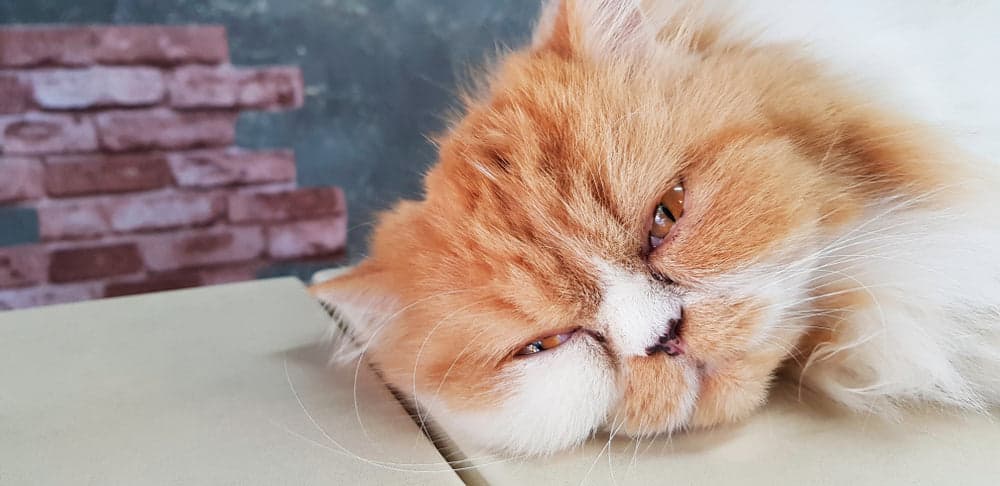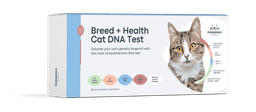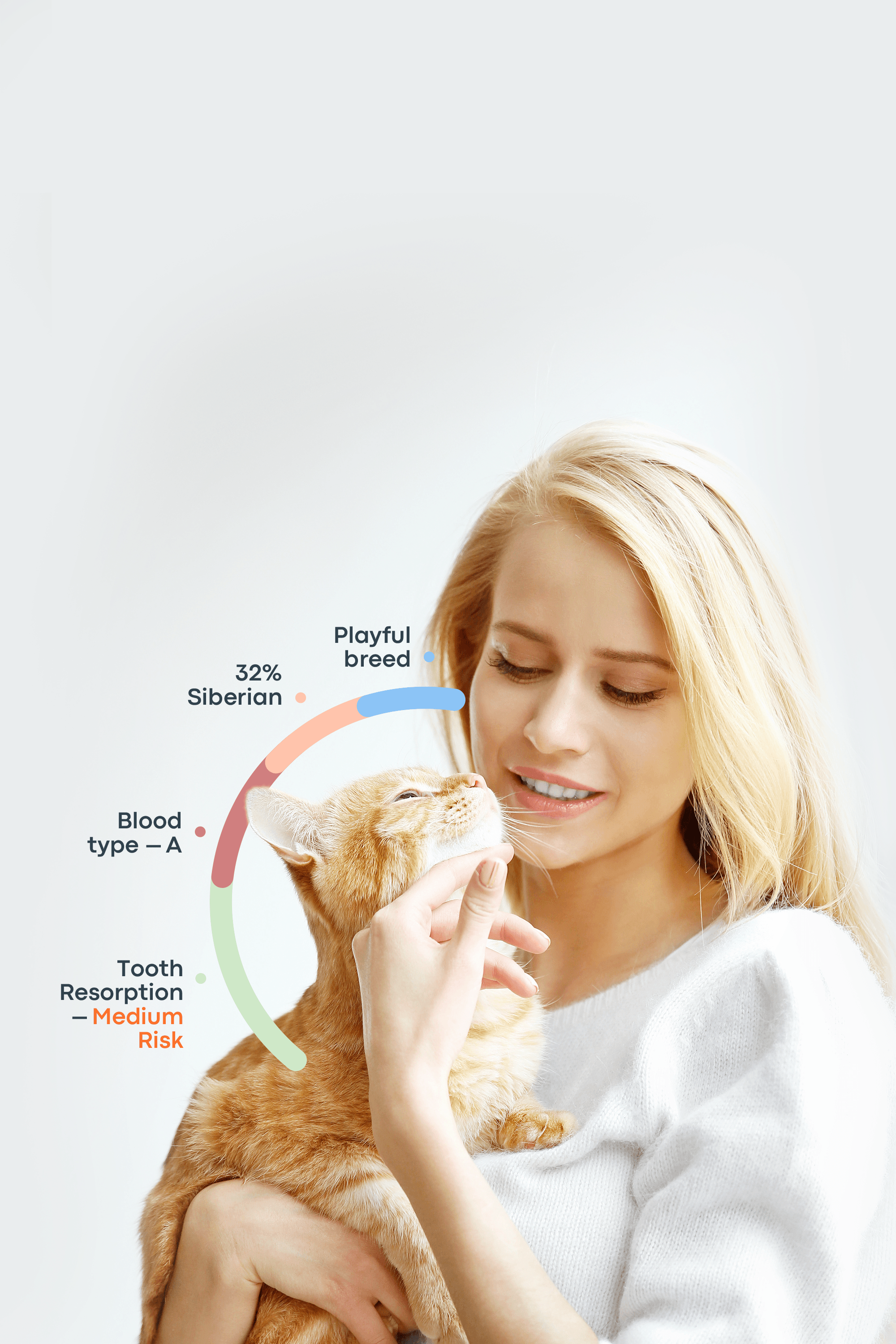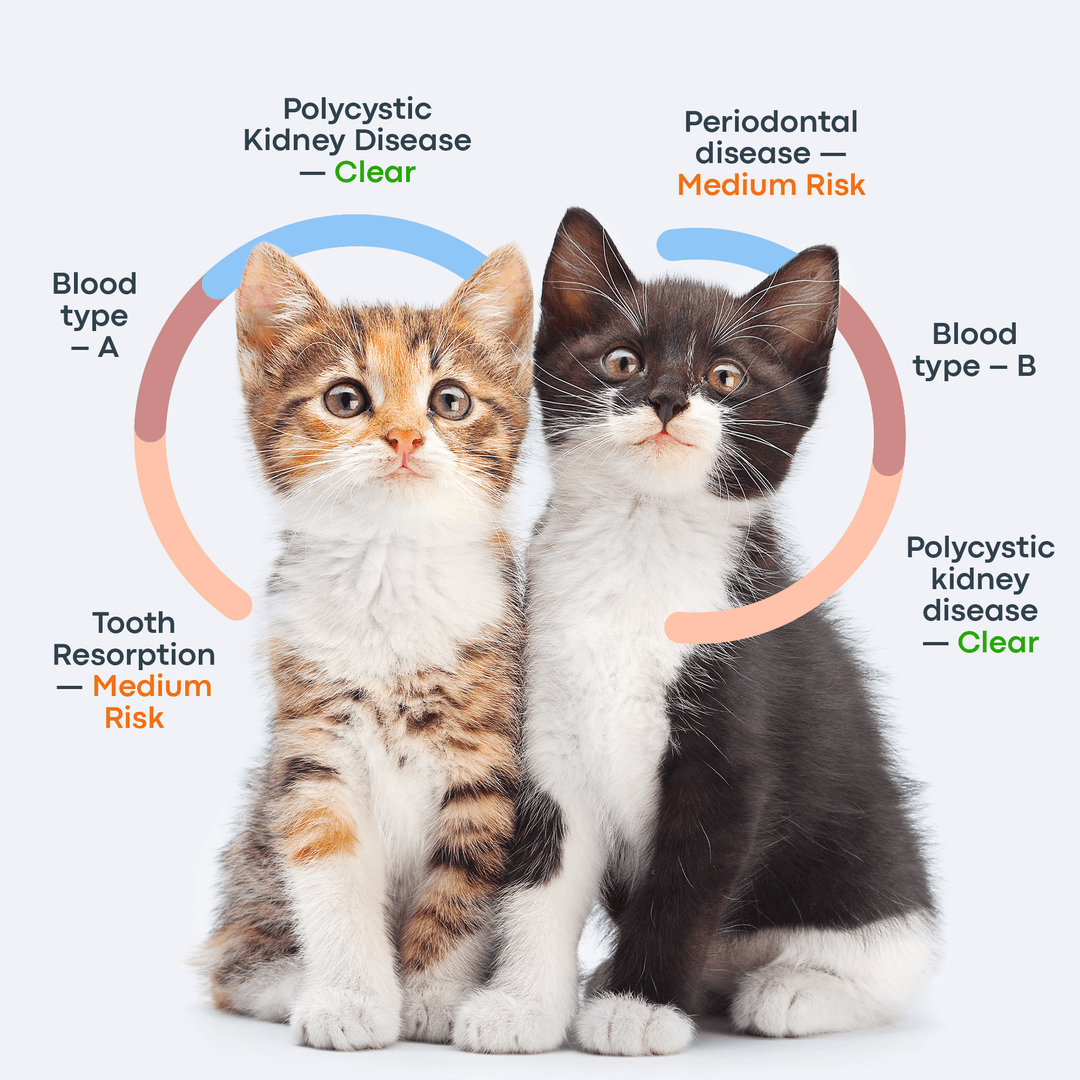Feline distemper, also known as feline panleukopenia (FP), is a serious and highly contagious viral disease caused by the feline parvovirus (FPV). The infection spreads rapidly among unvaccinated cats, particularly kittens, and can be life-threatening if not treated promptly.
It’s important to note that parvovirus in cats is not the same as the virus that causes parvovirus or distemper in dogs. Canine parvovirus and canine distemper virus are entirely different pathogens and do not infect cats.
Keep reading to learn more about feline distemper—its causes, symptoms, diagnosis, and available treatment options—as well as how vaccination and good preventive care can help protect your cat from this dangerous disease.
What Is Distemper in Cats?
Feline distemper, also known as feline panleukopenia or feline parvovirus infection, is a severe viral disease that targets cells in the body that divide rapidly. These include cells in the bone marrow, intestinal tract, skin, and even the developing tissues of unborn kittens. Because of this, the virus can affect multiple body systems, leading to serious and sometimes life-threatening complications.
According to PetMD, the feline parvovirus responsible for distemper attacks the bone marrow and suppresses the production of white blood cells. This weakens the cat’s immune system, leaving it vulnerable to secondary infections. The damage to the intestinal lining can also cause severe diarrhea, vomiting, and dehydration. In young or unvaccinated cats, the infection can progress quickly, and in pregnant cats, it may harm or even kill developing kittens.
The virus’s ability to destroy immune and intestinal cells makes feline distemper one of the most dangerous infectious diseases in cats—but fortunately, it’s also preventable through timely vaccination.

How Do Cats Get Distemper?
Feline distemper is found almost everywhere—in the United States and worldwide. A cat can become infected after coming into contact with the bodily fluids of an infected cat, such as saliva, urine, nasal discharge, or, most commonly, feces. The feline parvovirus that causes distemper is extremely resilient and can survive in the environment for months or even years, making it one of the most contagious and persistent viruses affecting cats.
The virus can contaminate many surfaces and objects, including food and water bowls, litter boxes, bedding, and even an infected cat’s paws or fur. It can also be carried indoors on human shoes or clothing, meaning that even indoor-only cats are not completely safe without vaccination. Because the virus can withstand cold temperatures and is resistant to many disinfectants, including alcohol and iodine, thorough cleaning and preventive measures are essential.
Kittens, unvaccinated cats, pregnant cats, and those with weakened immune systems are most at risk of contracting feline distemper. In unvaccinated cats, the disease often progresses rapidly and is considered one of the most fatal feline infections. Prompt veterinary care and proper vaccination are crucial for prevention and survival.
Feline Distemper Symptoms
The signs of feline distemper (feline panleukopenia) can appear suddenly and vary in severity depending on your cat’s age, health, and immune status. Because the virus affects rapidly dividing cells and suppresses the immune system, symptoms often involve the digestive tract, bone marrow, and nervous system.
Common symptoms include:
Symptom | Description / Notes |
Sneezing and nasal discharge | Can be mild or severe |
Watery or thick eye discharge | May indicate secondary infection |
Fever | May rise and fall unpredictably |
Dehydration | Often due to vomiting/diarrhea |
Loss of balance / ataxia | Nervous system involvement |
Diarrhea | Sometimes with blood |
Abdominal pain | Sensitivity on palpation |
Vomiting | Frequent in acute cases |
Loss of appetite | Refusal to eat |
Lethargy | Weakness or fatigue |
Depression / withdrawal | Behavioral change |
Pale gums | Possible anemia |
Reduced white blood cell count | Shown in lab tests |
In severe cases, symptoms can progress rapidly, leading to extreme dehydration, shock, and even death—especially in kittens or unvaccinated cats. If your cat shows several of these signs, seek veterinary care immediately, as early intervention can significantly improve the chances of recovery.
Is Distemper in Cats Curable?
Unfortunately, there is no specific cure for feline distemper (feline panleukopenia). Treatment focuses on managing symptoms, preventing secondary infections, and supporting the cat’s immune system while it fights the virus. But there is an answer to the question, “How to prevent parvo in cats?” Prevention through vaccination is absolutely essential — it’s the most effective way to protect your cat from infection.
With prompt veterinary care, some cats can recover from feline distemper, especially if treatment begins in the early stages of the disease. Cats that survive the infection typically develop lifelong immunity, meaning they will not get the disease again. However, the prognosis depends on the cat’s overall health and condition at the time of infection. A poorer outcome is often associated with:
Low protein levels
Low body temperature (hypothermia)
Poor body condition or extreme thinness
Severely reduced white blood cell count
Feline distemper can also lead to dangerous secondary complications. When the virus damages the intestinal lining, it causes severe diarrhea, vomiting, and loss of appetite, which can quickly result in dehydration. As the protective barrier of the intestines breaks down, bacteria can enter the bloodstream, leading to widespread infection (sepsis) and, in severe cases, death.
While there’s no antiviral medication that eliminates the virus, early veterinary intervention, intravenous fluids, nutritional support, and antibiotics to control secondary bacterial infections can significantly improve a cat’s chances of survival.

Can Cats Survive Distemper?
The chances of survival from cat parvo depend greatly on a cat’s age, overall health, and how quickly treatment begins. While the disease can be deadly, especially in kittens, prompt veterinary care can significantly improve the outcome.
Kittens
How do kittens get parvo? Kittens are especially vulnerable to feline distemper because their immune systems are still developing and they are often unvaccinated. They can easily contract the virus through direct contact with infected cats or contaminated environments. Unfortunately, kittens under two months old have the poorest prognosis, with mortality rates reported as high as 90% in some studies. Even with intensive care, their bodies often struggle to fight off the kitten parvo.
Adult cats
Older kittens and adult cats have a better chance of recovery, especially when they receive early and aggressive supportive treatment. This typically includes intravenous fluids to prevent dehydration, antibiotics to control secondary infections, and nutritional support. Survival rates for hospitalized cats are estimated between 20% and 51%, depending on the severity of illness and quality of care.
Overall health and speed of treatment
Cats in good health and those treated promptly tend to recover more successfully. Rapid veterinary intervention—before severe dehydration or dangerously low white blood cell counts develop—can make the difference between life and death. In well-managed cases, survival rates can reach 60–90%, though such outcomes are less common and depend on early diagnosis, strong immune function, and intensive care.
In short, the faster treatment begins and the stronger a cat’s immune system, the higher their odds of survival. Very young, sick, or untreated cats remain at the greatest risk from this highly contagious and aggressive disease.
Cat Category | Risk / Prognosis | Notes |
Kittens (<2 months, unvaccinated) | Very high mortality | Up to 90%, even with intensive care |
Older kittens / adult cats | Moderate to good | Survival rates 20–51% with hospitalization |
Healthy, promptly treated cats | Good | Survival 60–90%, depends on immune function & early care |
Sick / untreated cats | Poor | High risk of death |
Distemper in Cats: Diagnosis and Treatment
Veterinary Diagnosis
Diagnosing feline distemper (feline panleukopenia) requires a combination of clinical evaluation and laboratory testing. Your veterinarian will start by reviewing your cat’s medical history, vaccination status, and parvo cat signs such as fever, vomiting, diarrhea, and lethargy.
To confirm the diagnosis, the vet may perform:
Blood tests to check for a low white blood cell count (a common indicator of infection).
PCR (polymerase chain reaction) tests or ELISA tests to detect the presence of feline panleukopenia virus (FPV) in blood, feces, or tissue samples.
These tests also help rule out other illnesses with similar symptoms, such as feline leukemia virus (FeLV), feline immunodeficiency virus (FIV), or severe gastrointestinal infections. It’s worth noting that recently vaccinated cats can occasionally test false positive, as the test may detect harmless vaccine virus particles rather than an active infection.

Veterinary Treatment Options
While there is no specific antiviral cure for parvo in cats, prompt and aggressive supportive care can save many cats. The goal of treatment is to stabilize the cat, prevent dehydration, and manage symptoms while the immune system fights the virus.
Veterinarians may recommend:
Intravenous (IV) fluids to correct dehydration and restore electrolyte balance
Anti-nausea or anti-diarrheal medications to control vomiting and diarrhea
Antibiotics to prevent or treat secondary bacterial infections
Nutritional support, including syringe or feeding-tube assistance if the cat refuses to eat
Pain relief and fever management to reduce discomfort and help recovery
Cats receiving early, intensive care in a veterinary clinic have the best chance of survival. Once stabilized, cats may need ongoing home care, including hydration, warmth, and careful isolation from other cats to prevent spreading the virus.
Recovery and Management
Home Care
Caring for a cat recovering from feline distemper requires careful attention and supportive measures. Even after veterinary treatment, home care plays a vital role in recovery and preventing the spread of the virus.
Isolation: Keep your infected cat completely separate from other cats in your household. Feline parvovirus spreads easily through contact with bodily fluids, contaminated surfaces, or even shared food and water bowls.
Monitoring: Follow your veterinarian’s instructions for regular check-ups. This may include tracking your cat’s hydration, temperature, appetite, and white blood cell counts to ensure they are recovering safely.
Gradual Recovery: Cats that survive the critical first 5–7 days often begin to improve slowly over the next two weeks. During this period, provide a warm, quiet space, encourage eating, and continue supportive care as directed by your vet.
Vaccination and Prevention: Once your cat has fully recovered, thoroughly clean and disinfect their environment to remove lingering virus particles. Ensure that all cats in the household are fully vaccinated, as vaccination is the most effective way to prevent future outbreaks.
With diligent care and monitoring, many cats can recover from distemper and go on to live healthy lives, though prevention remains the most reliable defense against this serious disease.
How to Prevent Distemper in Your Cat
Now that you know the answer to the question, “How do cats get parvo?” it’s important to focus on prevention, which is the most effective way to protect your pet from this dangerous disease.
Vaccination Is Key
The American Animal Hospital Association (AAHA) considers the feline distemper vaccine (feline panleukopenia virus, FPV) a core vaccine for all cats. Consult your veterinarian to determine the appropriate vaccination schedule, especially if your cat’s medical history is unclear. General guidelines include:
Kittens: The first dose should be given at 6–8 weeks of age, with boosters every 3–4 weeks until the kitten is 16–20 weeks old.
Adult cats: Cats that have never been vaccinated should receive 1–2 initial doses, followed by booster shots every 1–3 years, depending on your veterinarian’s recommendation.
Indoor cats: Even cats kept strictly indoors should be vaccinated, as the virus can be brought into the home on shoes, clothing, or other objects.
When introducing a new cat to your home, keep them quarantined until you can confirm their vaccination records. This helps protect your other pets from potential exposure.
Environmental Control and Hygiene
Feline parvovirus is extremely hardy and can survive for months in the environment. To minimize the risk of infection:
Keep your cat away from animals that may be infected.
Regularly clean and disinfect your cat’s bedding, litter boxes, food and water bowls, and play areas. A bleach solution (½ cup bleach per gallon of water) is effective; allow it to sit on surfaces for 10 minutes before rinsing.
If you must handle an infected cat, wear disposable gloves and wash your hands thoroughly afterward to prevent spreading the virus to other pets.
By combining timely vaccination, careful hygiene, and environmental management, you can significantly reduce the risk of feline distemper and help your cat stay healthy.
Conclusion
Feline distemper (feline panleukopenia or parvovirus in cats) is a highly contagious and potentially life-threatening disease. The best way to protect your cat is through timely and complete vaccination, along with keeping their vaccinations up to date. Regular veterinary checkups are essential to monitor your cat’s overall health and catch any early signs of illness.
If you ever notice symptoms of distemper—such as vomiting, diarrhea, lethargy, or loss of appetite—contact your veterinarian immediately, as early intervention can make a critical difference.
Understanding feline distemper and other common cat viruses helps you stay proactive about your cat’s health, giving you more years of safe cuddles, play, and companionship with your furry friend.
Get Ahead of Other Health Issues With Basepaws
When it comes to other aspects of your cat's health, the Basepaws Breed + Health Cat DNA Test offers you the knowledge and insight you need to know your cat better, both inside and out. Learn about 25 genetic traits connected to your kitty’s unique appearance, and potentially life-saving information about their blood type and likelihood of resistance to the Feline Immunodeficiency Virus (FIV). By knowing your cat’s risk for common diseases, you can be proactive and support their well-being to help them live a better life, even longer!
Frequently Asked Questions
Is it possible for cats to contract canine distemper from playing with infected dogs?
No. Cats cannot get canine distemper from dogs. The viruses are species-specific: cats get feline distemper, while dogs get canine distemper.
Can stray kittens get distemper?
Yes. Stray kittens are especially vulnerable because they are often unvaccinated and may be exposed to the virus through contact with infected cats or contaminated environments.
Can indoor cats get panleukopenia?
Yes. Even indoor cats can contract panleukopenia, as the virus is highly contagious and can be brought into the home on shoes, clothing, or contaminated objects.



